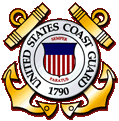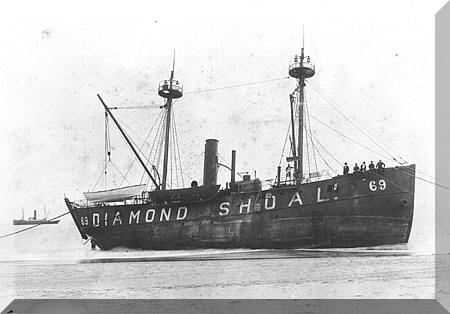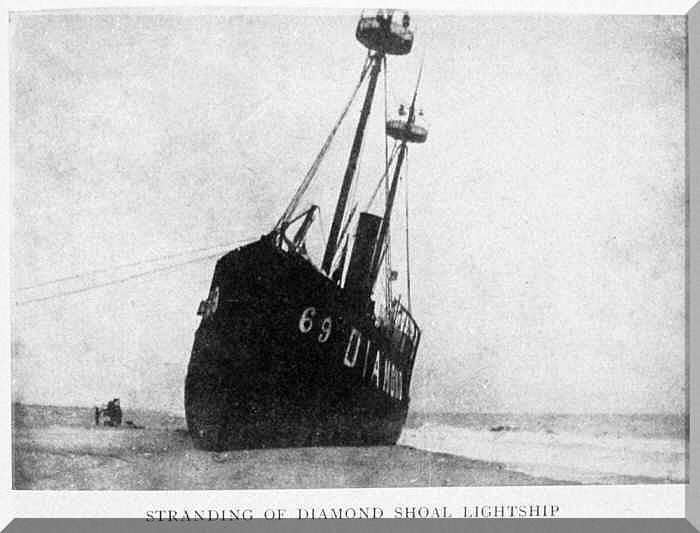



![]()




Other than having many close encounters with passing ships , the most dangerous problem was bad weather which often caused the lightships to either slip their moorings or snap their mooring chains causing them to go adrift , often many miles from their assigned stations . An interesting note : Of all the vessels assigned to Diamond Shoals reports indicate that Lightships assigned there were blown off station more than 22 times .


At least 2 of them were severely damaged including LV 69 which washed up on the beach and was later refloated and repaired in 1899 .
In 1930 a new class of Lightships ( these were called the 3rd generation of Lightships ) were built at Charleston , SC . Of this class at least 3 are still afloat , LV 114 /WAL 536 , LV 116 /WAL 538 and LV 115 /WAL 537 .
From this generation of Lightships LV 114 / WAL 536 took its assigned station at Diamond Shoals in 1945 , being built of boiler plate , riveted construction , without benefit of watertight compartmentation . This class of Lightships were steam propelled with coal fired boilers , and comfortable bunks for the crews sleeping areas . Ship to Shore radio equipment ,and radio beacons were installed along with an AM radio from which the crew could listen to their favorite music in the off duty hours . The galleys were supplied with either oil fired or coal fed stoves for cooking . TV became a fixture in the 1950s . Movies became available in the late 1940s making evenings more bearable . Card games , either cribbage or pinochle would last for the duration of a 3 week rotation on the Shoals .
LV 114 / WAL 536 , served at Diamond Shoals from 1945- 47 . LV 114 was one of the most uncomfortable Lightships with its leaking side loading doors , constant wetness ,and poor heating system . It was first assigned to Fire Island , NY in 1930 It also served at , Portland , Maine , and Pollock Rip in Mass.
The last Lightship assigned to Diamond Shoals was LV 189 , built for the USLHS at Bay City , Michigan . LV 189 was the prototype for the last class of Light Ships : LVs 196 , 604 , 605 , 612 , and LV 613 . This class of Lightships was of all welded design , with watertight integrity throughout the ship . These vessels were built very much like a submarine with vertical escape hatches from every compartment , from Bow to Stern . The worst problem the crews of these vessels endured was the stench of diesel fuel . The 189/196 class carried up to 40,000 gallons of diesel fuel , 20,000 gal.of potable water and several thousand gal.of lube oil . While at sea , engines were kept online , generators were running , pumps were working and the men had to insure that every piece of equipment was always at the ready .
The class of ships , of which LV 189 was included were built for the worst possible weather . With a quad of Detriot Diesel engines connected via a direct reversible clutch , it could get "underway" with all 4 main engines keeping its bow into the wind , to maintain its station , no matter what . The vessels 7,000 lb main mushroom anchor was a great innovation . The anchor was designed to fall into the sea floor and stay there .
The 189/196 class of Lightships had a wave breaker installed on its forepeak to prevent huge waves from crushing their wheelhouses . The main lights on the 189/196class of Lightships consisted of 4 banks of locomotive lanterns , with 6 lamps in each bank producing a spot/beam visible up to 18 miles . The Fog Signals were powerful F2T air driven devices which produced a sound that could be heard some 14 miles distant . The newer Lightships were also equipped with radio beacon equipment which broadcasted a 4 character "signature " hundreds of miles from the vessels . The radio beacon signal was used in conjunction with other Lightships or land based stations which also sent out radio signals to help other vessels accurately plot their courses .
LV 189 left Diamond Shoals in 1966 , ending an era for the people of the Outer Banks , thereby closing the book on the history of Lightships forever in N. Carolina . Lightships of the Outer Banks have been replaced by a stationary Tower at Diamond Shoals which could be supplied and maintained by USCG helicopters from Elizabeth City , NC .
Bibliography ;
Lightships of Cape Cod , F. Thompson
Lightships and Lightship Stations of The US Gov't., W. Flint
Archives of the US Coast Guard Lightship Sailors Association , DM Bingham , Historian/LSA
Lightship files of the late Edward Rowe Snow
Lighthouse and Lightships of the US Gov't., George R. Putnam
Acknowledgements to:
Mr Ken Black USCG Ret.
Mr Richard Bennett MK1 USCG Ret.
CWO Jim Gill USCG Ret.
Mrs Dorothy Snow Bicknell , Marshfield , Mass.
The station was replaced by the Diamond Shoal Light Tower.
1942-1945: marked by a buoy during World War II
Copyright © 2003 United States Coast Guard Lightship Sailors Association
INC. All rights reserved.
Copyrights also protected by the
Digital Millennium Copyright Act of
1998
Revised: 10/23/06.